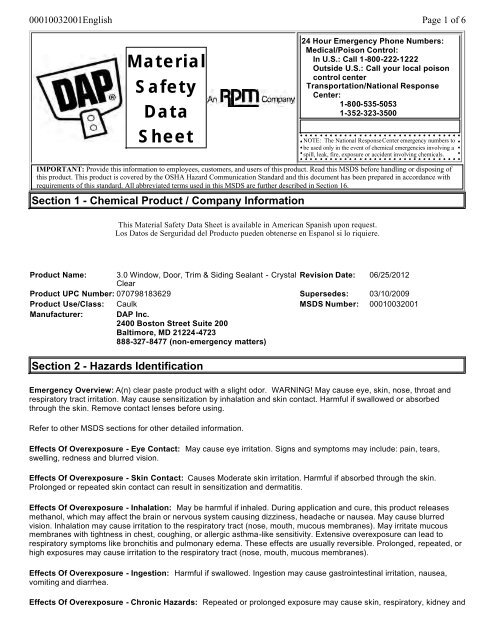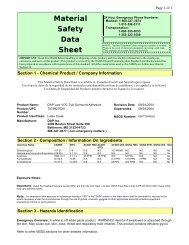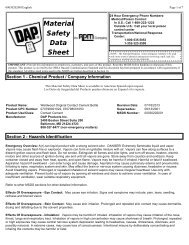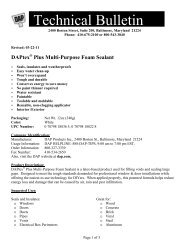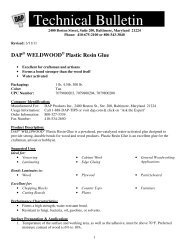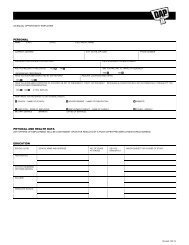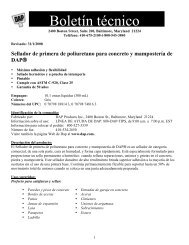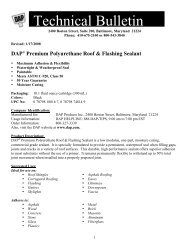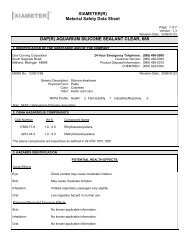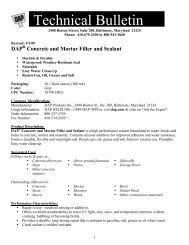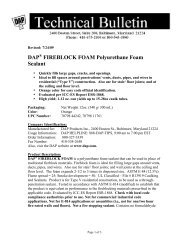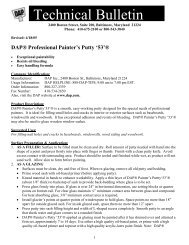3.0 Window, Door, Trim & Siding Sealant - Crystal Clear MSDS - Dap
3.0 Window, Door, Trim & Siding Sealant - Crystal Clear MSDS - Dap
3.0 Window, Door, Trim & Siding Sealant - Crystal Clear MSDS - Dap
You also want an ePaper? Increase the reach of your titles
YUMPU automatically turns print PDFs into web optimized ePapers that Google loves.
00010032001English<br />
Page 1 of 6<br />
Material<br />
Safety<br />
Data<br />
Sheet<br />
24 Hour Emergency Phone Numbers:<br />
Medical/Poison Control:<br />
In U.S.: Call 1-800-222-1222<br />
Outside U.S.: Call your local poison<br />
control center<br />
Transportation/National Response<br />
Center:<br />
1-800-535-5053<br />
1-352-323-3500<br />
NOTE: The National Response Center emergency numbers to<br />
be used only in the event of chemical emergencies involving a<br />
spill, leak, fire, exposure or accident involving chemicals.<br />
IMPORTANT: Provide this information to employees, customers, and users of this product. Read this <strong>MSDS</strong> before handling or disposing of<br />
this product. This product is covered by the OSHA Hazard Communication Standard and this document has been prepared in accordance with<br />
requirements of this standard. All abbreviated terms used in this <strong>MSDS</strong> are further described in Section 16.<br />
Section 1 - Chemical Product / Company Information<br />
This Material Safety Data Sheet is available in American Spanish upon request.<br />
Los Datos de Serguridad del Producto pueden obtenerse en Espanol si lo riquiere.<br />
Product Name: <strong>3.0</strong> <strong>Window</strong>, <strong>Door</strong>, <strong>Trim</strong> & <strong>Siding</strong> <strong>Sealant</strong> - <strong>Crystal</strong> Revision Date:<br />
<strong>Clear</strong><br />
06/25/2012<br />
Product UPC Number: 070798183629 Supersedes: 03/10/2009<br />
Product Use/Class: Caulk <strong>MSDS</strong> Number: 00010032001<br />
Manufacturer: DAP Inc.<br />
2400 Boston Street Suite 200<br />
Baltimore, MD 21224-4723<br />
888-327-8477 (non-emergency matters)<br />
Section 2 - Hazards Identification<br />
Emergency Overview: A(n) clear paste product with a slight odor. WARNING! May cause eye, skin, nose, throat and<br />
respiratory tract irritation. May cause sensitization by inhalation and skin contact. Harmful if swallowed or absorbed<br />
through the skin. Remove contact lenses before using.<br />
Refer to other <strong>MSDS</strong> sections for other detailed information.<br />
Effects Of Overexposure - Eye Contact: May cause eye irritation. Signs and symptoms may include: pain, tears,<br />
swelling, redness and blurred vision.<br />
Effects Of Overexposure - Skin Contact: Causes Moderate skin irritation. Harmful if absorbed through the skin.<br />
Prolonged or repeated skin contact can result in sensitization and dermatitis.<br />
Effects Of Overexposure - Inhalation: May be harmful if inhaled. During application and cure, this product releases<br />
methanol, which may affect the brain or nervous system causing dizziness, headache or nausea. May cause blurred<br />
vision. Inhalation may cause irritation to the respiratory tract (nose, mouth, mucous membranes). May irritate mucous<br />
membranes with tightness in chest, coughing, or allergic asthma-like sensitivity. Extensive overexposure can lead to<br />
respiratory symptoms like bronchitis and pulmonary edema. These effects are usually reversible. Prolonged, repeated, or<br />
high exposures may cause irritation to the respiratory tract (nose, mouth, mucous membranes).<br />
Effects Of Overexposure - Ingestion: Harmful if swallowed. Ingestion may cause gastrointestinal irritation, nausea,<br />
vomiting and diarrhea.<br />
Effects Of Overexposure - Chronic Hazards: Repeated or prolonged exposure may cause skin, respiratory, kidney and
00010032001English<br />
liver damage. Prolonged and repeated skin contact may cause irritation and possibly dermatitis.<br />
Page 2 of 6<br />
Primary Route(s) Of Entry: Skin Contact, Inhalation, Eye Contact<br />
Medical Conditions which May be Aggravated by Exposure: None known.<br />
Carcinogenicity:<br />
None<br />
Section 3 - Composition / Information On Ingredients<br />
Proprietary Phthalate Esters<br />
Chemical Name CASRN<br />
Proprietary<br />
Wt%<br />
15 -40<br />
Gamma-Aminopropyltrimethoxysilane 13822-56 -5 1-5<br />
Silica, amorphous 7631-86-9 1-5<br />
Section 4 - First Aid Measures<br />
First Aid - Eye Contact: In case of contact, immediately flush eyes with large quantities of water for at least 15 minutes<br />
until irritation subsides. Get medical attention immediately.<br />
First Aid - Skin Contact: Remove and wash contaminated clothing. Wash off immediately with soap and plenty of water<br />
for at least 15 minutes. Get medical aid if symptoms persist. In case of contact, immediately flush skin with plenty of water<br />
while removing contaminated clothing and shoes.<br />
First Aid - Inhalation: If inhaled, remove to fresh air. If breathing is difficult, leave the area to obtain fresh air. If<br />
continued breathing difficulty is experienced, get medical attention immediately. If you experience difficulty in breathing,<br />
leave the area to obtain fresh air. If continued difficulty is experienced, get medical attention immediately.<br />
First Aid - Ingestion: First Aid: If swallowed, get medical attention immediately. If swallowed, DO NOT INDUCE<br />
VOMITING. Get medical attention immediately. If ingested, irrigate the stomach.<br />
Note to Physician: None.<br />
COMMENTS: If over-exposure occurs, call your poison control center at 1-800-222-1222.<br />
Section 5 - Fire Fighting Measures<br />
Extinguishing Media: Carbon Dioxide, Dry Chemical, Foam, Water Fog<br />
Unusual Fire And Explosion Hazards: No special protective measures against fire required.<br />
Special Firefighting Procedures: Wear self-contained breathing apparatus pressure-demand (NIOSH approved or<br />
equivalent) and full protective gear. Use water spray to cool exposed surfaces.<br />
Section 6 - Accidental Release Measures<br />
Steps To Be Taken If Material Is Released Or Spilled: Wear proper protective equipment as specified in Section 8. Use<br />
personal protective equipment as necessary. Use absorbent material or scrape up dried material and place in container.<br />
Section 7 - Handling And Storage
00010032001English<br />
Handling: KEEP OUT OF REACH OF CHILDREN! DO NOT TAKE INTERNALLY. Use only with adequate ventilation.<br />
Open all windows and doors or use other means to ensure cross-ventilation and fresh air entry during application and<br />
drying. Odor is not an adequate warning for hazardous conditions. Avoid breathing vapor and contact with eyes, skin and<br />
clothing. Wash thoroughly after handling. Remove contact lenses before using. Do not handle contact lenses until all<br />
sealant has been cleaned from fingertips, nails and cuticles. Residual sealant may transfer to contact lenses and cause<br />
severe eye irritation.<br />
Storage: Close container after each use. Do not store at temperatures above 120 degrees F. Store containers away from<br />
excessive heat and freezing. Store away from caustics and oxidizers.<br />
Section 8 - Exposure Controls / Personal Protection<br />
Precautionary Measures: Please refer to other sections and subsections of this <strong>MSDS</strong>.<br />
Engineering Controls: Good general ventilation should be sufficient to control airborne levels. Ensure adequate<br />
ventilation, especially in confined areas. Local ventilation of emission sources may be necessary to maintain ambient<br />
concentrations below recommended exposure limits.<br />
Respiratory Protection: In case of insufficient ventilation, wear suitable respiratory equipment. A NIOSH-approved air<br />
purifying respirator with an organic vapor cartridge or canister may be necessary under certain circumstances where<br />
airborne concentrations are expected to exceed exposure limits. A respiratory protection program that meets the OSHA<br />
1910.134 and ANSI Z88.2 requirements must be followed whenever workplace conditions warrant a respirator's use.<br />
Skin Protection: Wear nitrile or neoprene gloves.<br />
Eye Protection: Goggles or safety glasses with side shields.<br />
Other protective equipment: Not required under normal use.<br />
Page 3 of 6<br />
Chemical Name CASRN ACGIH TWA ACGIH STEL ACGIH CEIL OSHA TWA OSHA STEL OSHA CEIL Skin<br />
Proprietary Phthalate Esters Proprietary N.E. N.E. N.E. N.E. N.E. N.E. No<br />
Gamma-Aminopropyltrimethoxysilane 13822-56-5 N.E. N.E. N.E. N.E. N.E. N.E. No<br />
Silica, amorphous 7631-86-9 10 MGM3 N.E. N.E. 5 MGM3 N.E. N.E. No<br />
Hygienic Practices: Wash hands before breaks and at the end of workday. Remove and wash contaminated clothing<br />
before re-use.<br />
Important: Listed Permissible Exposure Levels (PEL) are from the U.S. Dept. of Labor OSHA Final Rule Limits (CFR 29 1910.1000); these limits may vary<br />
between states.<br />
Note: An employee's skin exposure to substances having a "YES" in the "SKIN" column in the table above shall be prevented or reduced to the extent<br />
necessary under the circumstances through the use of gloves, coveralls, goggles or other appropriate personal protective equipment, engineering controls or work<br />
practices.<br />
Section 9 - Physical And Chemical Properties<br />
Boiling Range: Not Established Vapor Density: Heavier Than Air<br />
Odor: Slight Odor Threshold: Not Established<br />
Color: <strong>Clear</strong> Evaporation Rate: Slower Than n-Butyl Acetate<br />
Solubility in H2O: Not Established Specific Gravity: 1.03 - 1.03<br />
Freeze Point: Not Established pH: Not Applicable<br />
Vapor Pressure: Not Established Viscosity: Not Established<br />
Physical State: Paste Flammability: Non-Flammable<br />
Flash Point, F: Greater than 200 Method: (Seta Closed Cup)<br />
Lower Explosive Limit, %: Not Determined<br />
Upper Explosive Limit, %:Not Determined<br />
When reported, vapor pressure of this product has been calculated theoretically based on its constituent makeup and has not been determined experimentally.<br />
(See section 16 for abbreviation legend)
00010032001English<br />
Section 10 - Stability And Reactivity<br />
Page 4 of 6<br />
Conditions To Avoid: Excessive heat and freezing.<br />
Incompatibility: Incompatible with strong bases and oxidizing agents.<br />
Hazardous Decomposition Products: Normal decomposition products, i.e., COx, NOx.<br />
Hazardous Polymerization: Hazardous polymerization will not occur under normal conditions.<br />
Stability: Stable under recommended storage conditions.<br />
Section 11 - Toxicological Information<br />
Product LD50: Not Established<br />
Product LC50: Not Established<br />
No toxicological information is available.<br />
Significant Data with Possible Relevance to Humans: None.<br />
Section 12 - Ecological Information<br />
Ecological Information: Ecological injuries are not known or expected under normal use.<br />
Section 13 - Disposal Information<br />
Disposal Information: Dispose of material in accordance with all federal, state and local regulations. State and Local<br />
regulations/restrictions are complex and may differ from Federal regulations. Responsibility for proper waste disposal is<br />
with the owner of the waste.<br />
EPA Waste Code if Discarded (40 CFR Section 261): None.<br />
Section 14 - Transportation Information<br />
DOT Proper Shipping Not Regulated. Packing Group: N.A.<br />
Name:<br />
DOT Technical Name: N.A. Hazard Subclass: N.A.<br />
DOT Hazard Class: N.A. DOT UN/NA Number: N.A.<br />
Note: The shipping information provided is applicable for domestic ground transport only. Different categorization may<br />
apply if shipped via other modes of transportation and/or to non-domestic destinations.<br />
Section 15 - Regulatory Information<br />
CERCLA - SARA Hazard Category:<br />
This product has been reviewed according to the EPA 'Hazard Categories' promulgated under Sections 311 and 312 of<br />
the Superfund Amendment and Reauthorization Act of 1986 (SARA Title III) and is considered, under applicable<br />
definitions, to meet the following categories:<br />
Immediate Health Hazard, Chronic Health Hazard
00010032001English<br />
SARA Section 313:<br />
Page 5 of 6<br />
This product contains the following substances subject to the reporting requirements of Section 313 of Title III of the<br />
Superfund Amendment and Reauthorization Act of 1986 and 40 CFR part 372:<br />
None<br />
Toxic Substances Control Act:<br />
All ingredients in this product are either on TSCA inventory list, or otherwise exempt.<br />
This product contains the following chemical substances subject to the reporting requirements of TSCA 12(B) if exported<br />
from the United States:<br />
None<br />
New Jersey Right-to-Know:<br />
The following materials are non-hazardous, but are among the top five components in this product:<br />
Pennsylvania Right-to-Know:<br />
The following non-hazardous ingredients are present in the product at greater than 3%:<br />
California Proposition 65:<br />
Chemical Name<br />
Silylated Polyurethane Resin<br />
Proprietary<br />
Cyclotetrasiloxane, octamethyl-, reaction prods. with silica 68583-49-3<br />
Chemical Name<br />
Silylated Polyurethane Resin<br />
Proprietary<br />
Cyclotetrasiloxane, octamethyl-, reaction prods. with silica 68583-49-3<br />
CAS Number<br />
WARNING: This product contains chemicals known to the State of California to cause cancer, birth defects or other<br />
reproductive harm.<br />
Section 16 - Other Information<br />
CAS Number<br />
HMIS Ratings:<br />
Health: 1 Flammability: 1 Reactivity: 0 Personal Protection: X<br />
Volatile Organic Compounds (VOC), less water less exempts: g/L: 19.3 lb/gal: 0.16 wt:wt%: 1.9<br />
Volatile Organic Compounds (VOC), less water less exempts, less LVP-VOCs: wt:wt%: 0.6<br />
REASON FOR REVISION: Periodic Update<br />
Legend: N.A. – Not Applicable ACGIH – American Conference of Governmental Industrial Hygienists<br />
N.E. – Not Established SARA – Superfund Amendments and Reauthorization Act of 1986<br />
N.D. – Not Determined<br />
NJRTK – New Jersey Right-to-Know Law<br />
VOC – Volatile Organic Compound<br />
OSHA – Occupational Safety and Health Administration<br />
PEL – Permissible Exposure Limit<br />
HMIS – Hazardous Materials Identification System
00010032001English<br />
TLV – Threshold Limit Value<br />
NTP – National Toxicology Program<br />
Page 6 of 6<br />
CEIL – Ceiling Exposure Limit<br />
STEL – Short Term Exposure Limit<br />
LD50 – Lethal Dose 50 LC50 – Lethal Concentration 50<br />
F – Degree Fahrenheit<br />
<strong>MSDS</strong> – Material Safety Data Sheet<br />
C – Degree Celsius<br />
CASRN – The Chemical Abstracts Service Registry Number<br />
DAP believes the data and statements contained herein are accurate as of the date hereof. They are offered in good faith as typical<br />
values and not as a product specification. NO WARRANTY OF MERCHANTABILITY, WARRANTY OF FITNESS FOR ANY<br />
PARTICULAR PURPOSE OR ANY OTHER WARRANTY, EXPRESS OR IMPLIED, IS MADE WITH REGARD TO THE<br />
INFORMATION HEREIN PROVIDED OR THE PRODUCT TO WHICH THE INFORMATION REFERS. Since this<br />
document is intended only as a guide to the appropriate use and precautionary handling of the referenced product by a properly trained<br />
person, it is therefore the responsibility of the user to (i) review the recommendations with due consideration for the specific context<br />
of the intended use and (ii) determine if they are appropriate.<br />


